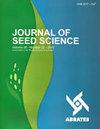大豆种子机械损伤处理:对其生理电位的影响
IF 1.2
4区 农林科学
Q3 AGRONOMY
引用次数: 6
摘要
摘要:机械损伤是影响大豆种子生理潜能的一个严重问题,特别是与化学处理相结合时。本研究旨在探讨化学处理对机械损伤程度增加的大豆种子生理潜能的影响。大豆种子(cv;在可控的情况下,对两批不同活力的M6410 IPRO进行了五级机械损伤(零、一、二、三、四次冲击)。在对种子物理完整性的影响进行了表征(x射线、x射线显微断层扫描、四氮唑和次氯酸钠)后,对种子进行了四种化学处理组合,包括杀菌剂(多菌灵和硫胺)、杀虫剂(吡虫啉和硫代敌敌畏)、微量营养素(钴和钼)、聚合物(Peridiam®)和干燥粉(Talkum Gloss®)。化学处理60 d后测定种子萌发率和活力。机械损伤的逐渐增加,特别是导致种皮开裂的机械损伤,降低了大豆种子的生理潜能,增加了它们对化学处理的植物毒性作用的敏感性。种皮的物理完整性对化学种子处理技术的成功至关重要。本文章由计算机程序翻译,如有差异,请以英文原文为准。
Treatment of soybean seeds with mechanical damage: effects on their physiological potential
Abstract: Mechanical damage is a serious problem for the physiological potential of soybean seeds, especially when combined with chemical treatment. The aim of this study was to investigate the effects of chemical treatment on the physiological potential of soybean seeds with increasing levels of mechanical damage. Soybean seeds (cv. M6410 IPRO) of two lots with differences in vigor were subjected to five levels of mechanical damage (zero, one, two, three, and four impacts) brought about in a controlled manner. After characterization of the effect of the impacts on seed physical integrity (X-ray, X-ray microtomography, tetrazolium, and sodium hypochlorite), the seeds were subjected to four combinations of chemical treatment with fungicides (carbendazim and thiram), insecticides (imidacloprid and thiodicarb), micronutrients (cobalt and molybdenum), polymer (Peridiam®), and drying powder (Talkum Gloss®). Seed germination and vigor were evaluated sixty days after chemical treatment. A progressive increase in mechanical damage, especially that which causes cracks in the seed coat, reduces the physiological potential of soybean seeds and increases their sensitivity to the phytotoxic effect of the chemical treatment. The physical integrity of the seed coat is crucial for the success of technologies used for chemical seed treatment.
求助全文
通过发布文献求助,成功后即可免费获取论文全文。
去求助
来源期刊

Journal of Seed Science
Agricultural and Biological Sciences-Agronomy and Crop Science
CiteScore
2.00
自引率
30.00%
发文量
28
审稿时长
12 weeks
期刊介绍:
From 2017 the Journal of Seed Science (JSS) will circulate online version only.
Original scientific studies and communications, not yet published or submitted to another journal for publication and written in Portuguese or English, will be accepted for publication. For manuscripts submitted in English, the authors should provide an adequated version.
The SCIENTIFIC COMMUNICATION is a category of scientific manuscript which describes a technique, an equipment, new species or observations and surveys of limited results. It has the same scientific rigor as the “Scientific Articles” and the same value as a publication. The classification of a manuscript as a SCIENTIFIC COMMUNICATION is based on its content and scientific merit but it can be a preliminary study, simple and not definitive on a certain subject, with publication justified by its uniqueness and contribution to the area.
The Editorial Board of the JSS may invite leading authors of recognized reputation to compose specific Review Articles covering topics of their specialization that will convey to the scientific community the state-of-the-art knowledge related to the specific theme.
 求助内容:
求助内容: 应助结果提醒方式:
应助结果提醒方式:


